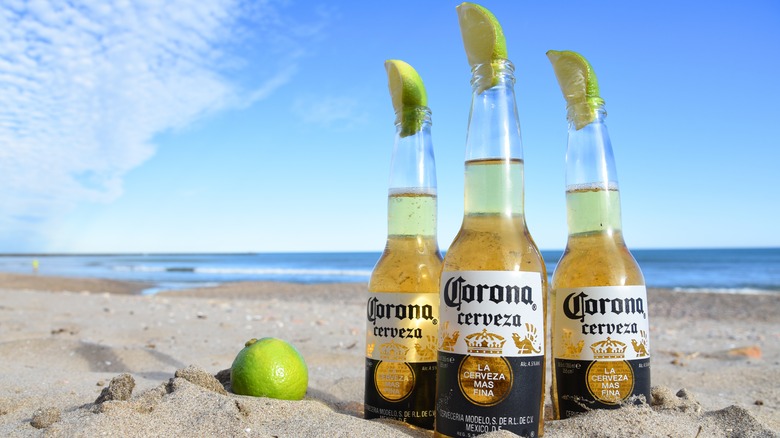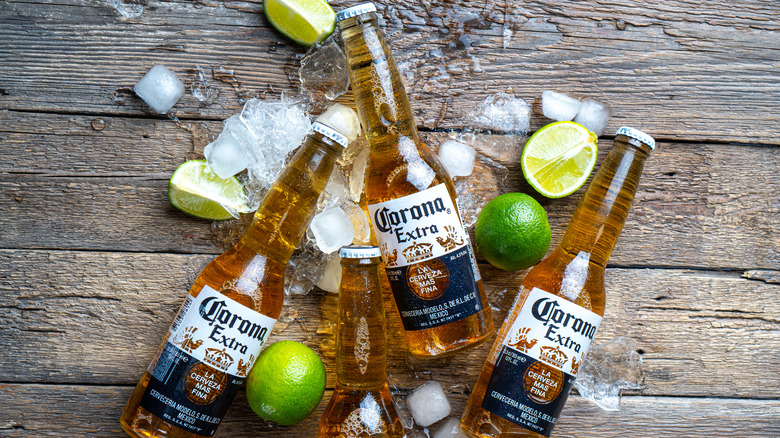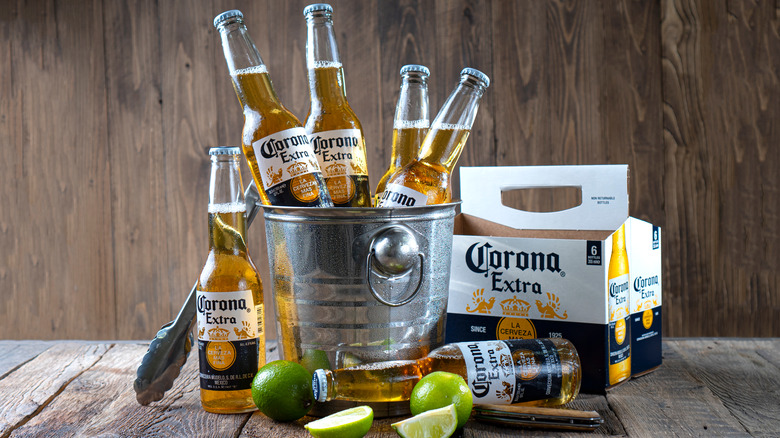The Murky Origins Behind Why Coronas Always Come With A Lime
For many, there's hardly a more refreshing beverage than an ice-cold Corona, specifically the original Corona Extra, with a wedge of lime. The pairing has become almost sacred and has been a key aspect of Corona's image in commercials, print ads, and partnerships for years.
It may then surprise you to learn that the pairing is neither historical nor easily traceable in origin, though there are plenty of theories. On the historical side, there's little to no evidence that locals paired the two before it caught on with the rest of the world, and Corona has been around since 1925. In fact, locals still refrain from using lime in Corona, finding that's more of a foreign concept.
As to its origins, there are several theories. Most are a matter of practicality, such as the idea that the lime disinfects the mouth of the bottle or that lime "deskunks" Corona's sometimes strong smell and taste that's caused by light exposure. But the theory that it was a friendly bet, albeit game-changing ones, by a bartender in 1981 that's the most entertaining.
The practical theories behind Corona's history with lime
The four practical theories behind Corona and lime's origin are matters of cleanliness, protection, and taste. One cleanliness theory claims lime's powers as a disinfectant and antibacterial was applied to the mouths of Corona bottles to fight against possible contamination. The other cleanliness theory has lime being used to remove rust from bottle mouths should the metal caps leave any behind. Since no factory can be perfectly clean and since metal bottle caps can still leave rust behind today, these are strong possibilities.
The protective theory proposes that lime wedges guarded Corona bottles against flies since flies dislike citrus. However, Mexico has been a top producer of limes, lemons, oranges, and grapefruits for decades. With easy access to all these citrus sources, the question of why use lime specifically and consistently over other citruses goes unanswered.
The final theory has some considerable science backing it up. But first, some homework. Almost all beer contains hops. When ultraviolet light, i.e. the sun, hits the hops in beer, a reaction occurs almost instantly that creates a chemical called 3-MBT — similar to a chemical also found in skunk spray. That's why other refreshing Mexican beers use brown or green bottles, to block UV light and limit this skunkification. Since Corona Extra bottles are clear, the beer is all but guaranteed to get skunky. Returning to the final theory now, it posits that lime masks this yucky smell and improves the flavor.
Corona and lime: powerful story, powerful symbol
While Occam would stop, satisfied, with a practical resolution, others may prefer a more entertaining truth. The best of these states a mysterious bartender placed a bet with a friend that they could start a lime-in-Corona trend. Other versions of the story claim the bartender acted alone and was only trying to sell more Coronas, get rid of excess limes, or both. Sadly, no versions of the bartender story are likely as the original source of the story doesn't name a person or a specific bar — so it can't be verified. The marketing ploy aspect does bear some consideration, and it's more likely the idea came from a boardroom pitch than from one mysterious, enterprising bartender.
We may never know the facts, but the truth of the matter is the pairing genuinely works. Some may dislike lime, but others are busy using tricks to get even more lime flavor in their Coronas. No matter your flavor preference, the imagery of the wedge poking out of the bottle is undeniably striking. More so when paired with its frequent tertiary partner, a beach. There's also the satisfying ritual of popping the cap, dropping in the wedge, and taking that first golden sip. Regardless of your lime preferences, or even if you're only using Coronas for a CoronaRita cocktail, remember to embrace "La Vida Más Fina" and enjoy responsibly.


